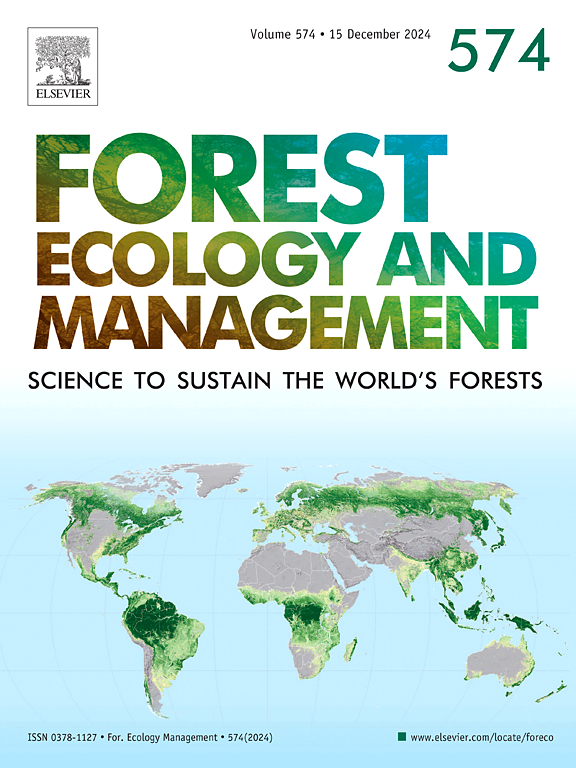Logging plus post-logging thinning may be enough to reduce cutting cycle of some Amazonian tree species
IF 3.7
2区 农林科学
Q1 FORESTRY
引用次数: 0
Abstract
This article brings new and refined results useful for the species-specific management in the Amazon Forest. The aim was twofold: (1) to evaluate the medium-term effect of post-logging thinning on the diameter growth of three commercial tree species (Protium apiculatum Swart., Tachigali chrysophylla (Poepp.) Zarucchi & Herend., Minquartia guianensis Aubl.); and (2) to propose species-specific minimum cutting diameters and cutting cycles. The experiment was conducted in the Tapajós National Forest, Brazilian Amazon, where two treatments were implemented: ‘T0’ – unmanaged forest, control; ‘T1’ – managed forest, harvesting of competitor trees with diameter ≥ 45 cm (average reduction of ∼ 30.18 % of the original basal area). Growth models without explicit age were fitted at the tree-species level to project diameter growth. As a result, T. chrysophylla exhibited the fastest growth and the most positive response to ‘T1’. This treatment successfully accelerated the growth rates and boosted the maximum diameter threshold of the three studied species. Extra periodic annual increments provided by ‘T1’ in relation to ‘T0’ varied among species and initial diameter size, reaching the highest value of 0.55 cm year−1 (i.e., 55 cm in 100 years) for M. guianensis. Species-specific minimum cutting diameters varied from 16–32 cm for 'T0' and 23–43 cm for 'T1'. Species-specific cutting cycles varied from 16–35 years for 'T0' and 13–28 years for 'T1', indicating that the generic cutting cycle of 35 years is safe for all species without post-logging thinning, and of 28 years if 'T1' is applied. We concluded that the growth rates vary among species submitted to a same treatment, indicating that the minimum cutting diameter and cutting cycle are sensitive to thinning effects. Our model suggests that the species T. chrysophylla and M. guianensis attain their optimal production volume within the period of 25 years, but this period is insufficient for the species P. apiculatum, although more research is needed to confirm these results in different locations in the Amazon. Our study also demonstrates that wood productivity and sustainability of forest ecosystems in the Amazon can be better linked through a species-specific approach.
伐木加上伐木后的疏伐可能足以缩短亚马逊某些树种的砍伐周期
这篇文章带来了新的和完善的结果,对亚马逊森林的特定物种管理很有帮助。目的有二:(1)评估伐木后疏伐对三种商品树种(Protium apiculatum Swart.、Tachigali chrysophylla (Poepp.) Zarucchi & Herend.、Minquartia guianensis Aubl.)直径增长的中期影响;(2)提出针对特定树种的最小伐木直径和伐木周期。实验在巴西亚马逊的塔帕约斯国家森林进行,采用两种处理方法:"T0"--无管理森林,对照;"T1"--管理森林,采伐直径≥ 45 厘米的竞争树(平均减少原基部面积的 30.18%)。在树种层面拟合了无明确树龄的生长模型,以预测直径的增长。结果,T. chrysophylla 的生长速度最快,对 "T1 "的反应也最积极。这种处理方法成功地加快了三个研究树种的生长速度,并提高了最大直径阈值。与 "T0 "相比,"T1 "提供的额外周期性年增量因物种和初始直径大小而异,M. guianensis的最高值为每年0.55厘米(即100年55厘米)。特定物种的最小切割直径在 "T0 "和 "T1 "之间变化,"T0 "为 16-32 厘米,"T1 "为 23-43 厘米。物种特定的砍伐周期在 "T0 "和 "T1 "之间变化,"T0 "为 16-35 年,"T1 "为 13-28 年,这表明在没有伐后疏伐的情况下,35 年的通用砍伐周期对所有物种都是安全的,如果采用 "T1",则为 28 年。我们得出的结论是,在相同处理条件下,不同树种的生长率各不相同,这表明最小伐木直径和伐木周期对疏伐效果很敏感。我们的模型表明,T. chrysophylla 和 M. guianensis 可在 25 年内达到最佳生产量,但对于 P. apiculatum 而言,这一期限是不够的。我们的研究还表明,通过针对具体物种的方法,可以更好地将木材生产力与亚马逊森林生态系统的可持续性联系起来。
本文章由计算机程序翻译,如有差异,请以英文原文为准。
求助全文
约1分钟内获得全文
求助全文
来源期刊

Forest Ecology and Management
农林科学-林学
CiteScore
7.50
自引率
10.80%
发文量
665
审稿时长
39 days
期刊介绍:
Forest Ecology and Management publishes scientific articles linking forest ecology with forest management, focusing on the application of biological, ecological and social knowledge to the management and conservation of plantations and natural forests. The scope of the journal includes all forest ecosystems of the world.
A peer-review process ensures the quality and international interest of the manuscripts accepted for publication. The journal encourages communication between scientists in disparate fields who share a common interest in ecology and forest management, bridging the gap between research workers and forest managers.
We encourage submission of papers that will have the strongest interest and value to the Journal''s international readership. Some key features of papers with strong interest include:
1. Clear connections between the ecology and management of forests;
2. Novel ideas or approaches to important challenges in forest ecology and management;
3. Studies that address a population of interest beyond the scale of single research sites, Three key points in the design of forest experiments, Forest Ecology and Management 255 (2008) 2022-2023);
4. Review Articles on timely, important topics. Authors are welcome to contact one of the editors to discuss the suitability of a potential review manuscript.
The Journal encourages proposals for special issues examining important areas of forest ecology and management. Potential guest editors should contact any of the Editors to begin discussions about topics, potential papers, and other details.
 求助内容:
求助内容: 应助结果提醒方式:
应助结果提醒方式:


